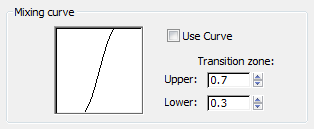With the Mix map, you can combine two colors or materials on a single side of the surface. You can also animate the Mix Amount parameter, and draw map morphing function curves to control how the two maps are blended over time.

Mix map blends skull and crossbones with the reflected scene.
Viewports can display both maps in a mix map.
Procedures
To change a component color:
- On the Mix Parameters rollout, click one of the two color swatches to display the Color Selector.
- Adjust the color.
To use a map as a color component:
- On the Mix Parameters rollout, click a map button next to one of the two color swatches.
3ds Max opens the Material/Map Browser.
- Select a map type.
Alternatively, use the Slate Material Editor to wire a map to the Color 1 or Color 2 component.
To exchange the two component colors:
- On the Mix Parameters rollout, click Swap.
To control the mix amount:
- On the Mix Parameters rollout, adjust the Mix Amount value.
Mix Amount is the percentage of Color #2 used in the mix.
You can also control the mix amount by using a map.
To control the mix amount using a map:
- On the Mix Parameters rollout, click the map button next to Mix Amount.
3ds Max opens the Browser so you can select a map type.
Alternatively, use the Slate Material Editor to wire a map to the Mix Amount component.
The intensity of pixels in this mixing map controls the mix. When the intensity is close to 0, one of the component colors or maps is visible; when it is close to full intensity, the other component is visible.
Tip: Using a Noise map for the mixing map can give good effects that have a natural appearance.In the Mix Parameters rollout, Mix Amount is inactive while a map is assigned to this parameter. If Use Curve is off, the mixing map is used as is. If Use Curve is on, you can shift the effect of the mixing map's gradient ramp, offsetting it one way or the other and revealing more or less of the mix components.
To control the mix amount using the mix curve:
- In the Mixing Curve group, turn on Use Curve.
- Change the shape of the curve by adjusting the Transition Zone values.
Interface

- Swap
- Exchanges the two colors or maps.
- Color # 1, Color # 2
- [color swatch] Click to display the Color Selector to select the two colors to be mixed.
[Maps] Select or create the bitmaps or procedural maps to be mixed instead of each color.
Black areas of the map reveal color #1, and white areas of the map reveal color #2. Gray values reveal intermediate mixes.
The checkboxes enable or disable their associated maps.
- Mix Amount
-
Determines the proportion of the mix. A Mix Amount of 0.0 means only Color 1 is visible on the surface; a Mix Amout of 100.0 means only Color 2 is visible. You can also use a map instead of the mix amount. The two colors will mix in greater or lesser degree according to the intensity of the map.
Mixing Curve group

These parameters control how gradual or how sharp the transition between the two colors being mixed will be. (This really only has meaning when you have a map applied to Mix Amount.)
- Use Curve
- Determines whether the Mixing Curve effects the mix.
- Transition Zone
- Adjusts the level of the upper and lower limits. If the two values are the same, the two materials will meet at a definite edge. Wider ranges give more gradual mixing.